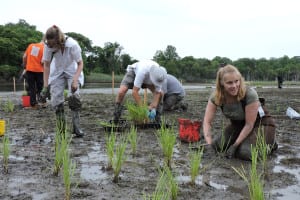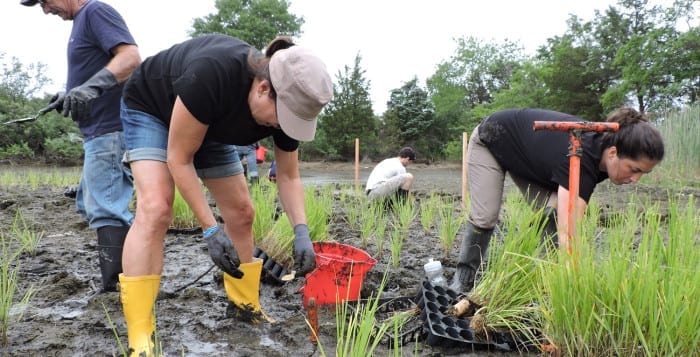Sunken Meadow State Park puts down new roots
It wasn’t pretty, but it was still pretty necessary.
More than 50 volunteers came together over the weekend to plant an acre of native Spartina cordgrass at Sunken Meadow State Park in Smithtown. The planting event was one of the first major public steps in a multiyear grant to restore river and marsh habitat and strengthen the park’s resilience to severe storms.
The $2.5 million project is funded by the Hurricane Sandy Competitive Grant Program and administered by Save the Sound with a team of governmental and nonprofit partners. Sunken Meadow State Park comprises 1,300 acres including the mouth of the Nissequogue River, salt and tidal marshes, dunes, coastal forest and three miles of Long Island Sound beachfront. Attracting over 2 million visitors a year, it is often dubbed the most popular state park in the New York City metro area.
Historically, Sunken Meadow Creek connected over 120 acres of marsh habitat with the Nissequogue estuary and the Sound, but in the 1950s, the Army Corps of Engineers built an earthen dike across the creek, restricting its tidal flow and fundamentally changing the marsh’s plant community, a spokeswoman for Save the Sound said. The Sunken Meadow Restoration team has been working since 2008 to restore tidal flow to the creek. Hurricane Sandy hit the park in October 2012. Its storm surge blew through the dike, fully reconnecting the marsh to the estuary for the first time in 60 years.

“Now that tidal flow is restored to Sunken Meadow Creek, we’re excited to combine marsh restoration, green infrastructure and public education to have an even greater impact,” said Gwen Macdonald, habitat restoration director for Save the Sound, a bi-state program of Connecticut Fund for the Environment. “It’s an amazing opportunity to show millions of people what a comprehensive program for a healthy coastal ecosystem can look like, with less water pollution, better tidal flow and vibrant marshes for thriving bird, fish and wildlife populations.”
Several environmental groups from state and local levels joined forces starting in 2012 to develop a plan to build on this reconnection and prepare the park’s ecosystem for future storms. The Sunken Meadow Comprehensive Resilience and Restoration Plan was established to manage stormwater, bulk up resilience of the marshes, explore improvements to riverine habitat and improve public knowledge and understanding of the ecological communites at the park.
“Today’s planting event is a first step in restoring historic tidal wetlands at Sunken Meadow State Park,” said Amanda Bassow, director of the northeastern regional office for the National Fish and Wildlife Foundation.
“We are thrilled to be able to support this project in partnership with the Department of the Interior through the Hurricane Sandy Coastal Resiliency Competitive Grant Program. The project will provide many benefits including strengthening natural coastal buffers to large storms, increasing wildlife habitat and improving water quality in the park and the surrounding waters of Long Island Sound.”
Sunday’s planting was not the only activity at the park this summer. New York Parks Department and Save the Sound have hired a summer education staffer to engage tourists and local students around issues of native versus invasive species, stormwater runoff, climate change preparedness and other topics, with a focus on opening opportunities for young nature lovers to become citizen-scientists.
The next step in the project, according to Save the Sound, is designing green infrastructure solutions for a 12-acre parking lot that drains into Sunken Meadow Creek. Incorporating stormwater best management practices in the design will reduce the pollutants that run off the parking lot and allow water to percolate into the ground, improving water quality in the creek for the wildlife that calls it home.







